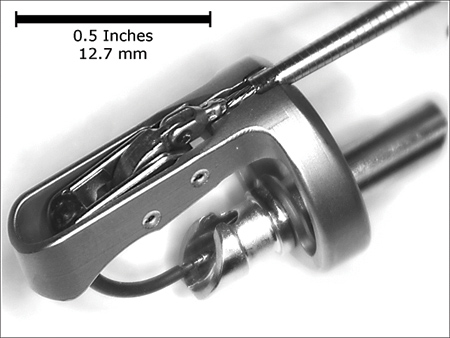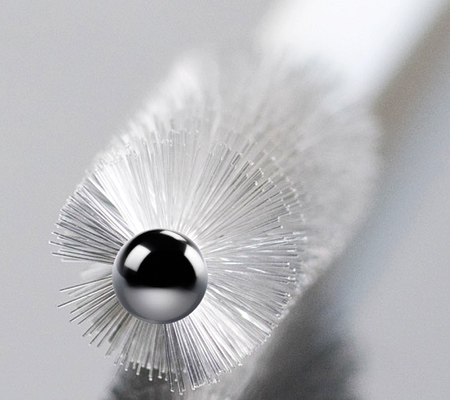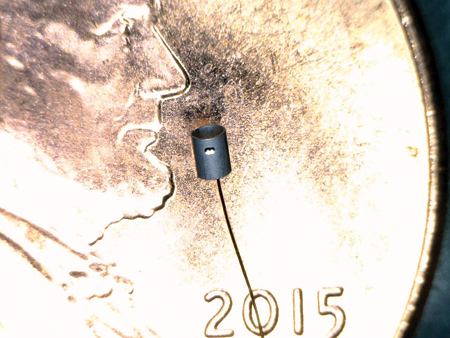
Apollo Endosurgery Overstitch System, with 12 laser welded joints, seven of which are visible in this photo.

Laser welding creates a smooth sphere on the tips of a twisted wire brush used in cytology.

Laser welding enables the manufacture of this minimally invasive surgical component, shown on a U.S. penny.
We live in a technological age where almost anything is possible. Take lasers, for example. The steady stream of new laser-related technologies has forever changed manufacturing as we knew it. New capabilities are driving new markets into existence. 3-D printing is but one obvious example. New and better lasers are being developed and new applications are emerging to take full advantage.
Industry is taking notice. The medical device industry, for one, is benefiting from the recent advances in industrial lasers; a welcome trend in an age of out-of-control medical costs. The costs and quality of healthcare are largely influenced by the state of manufacturing technologies available to build complex medical devices and machinery that diagnose, prevent and treat countless medical conditions. This equipment traditionally played a key role in the perpetual rise of healthcare costs; costly for medical OEMs to manufacture and expensive for providers to purchase and use.
The evolution of industrial lasers is shifting this paradigm by changing the way we manufacture medical devices. The result is lower costs to medical device OEMs and better, less expensive tools for healthcare providers.
Breakthroughs in Laser Technology
Lasers have evolved significantly over the past 15 years, due in large part to improvements in the laser resonator, the place where the laser beam is born and whose lasing medium determines its operating wavelength. A popular wavelength for industrial laser processing happens to be 1 micron. Until about 10 years ago, 1 micron industrial lasers were horribly inefficient. Just 3% of the energy from the wall plug ever made it into the laser beam, with the rest wasted as heat. As luck would have it, two competing resonator designs, developed by competing laser OEMs, emerged simultaneously to capture the lion's share of the existing 1 micron market. Not only do these designs offer vast improvements in efficiency, reliability and power scaling, but they also compete with each other, having the simultaneous effects of driving the laser price down while improving its performance. To those in the field, I am referring, of course, to the disk and fiber lasers.
The pictured surgical tool demonstrates the benefits provided by contemporary laser welding technology. This attachment for a standard endoscope allows surgeons to make sutures on the inside of the stomach, esophagus or lower intestine to treat a number of conditions without invasive surgery. The device is assembled with a total of 12 laser welds, many on components smaller than a grain of rice. Traditional tools and approaches were not capable of producing such delicate parts economically until recent advances in laser technology.
In 2006 Joining Technogies bought and installed the very first 2 kilowatt disk laser used for manufacturing in North America. It felt like we had bought the very first iPhone. Within 18 months we saw the same laser, only newer and better, selling on the market for 30% less!
Laser welding was an early beneficiary of this new trend in disk and fiber lasers. Old lamp pumped lasers were (and are) being replaced by them. The new lasers are smaller, more powerful and efficient, and importantly, less expensive to purchase and to operate than their predecessors. New and improved optics and power supplies are delivering higher powers onto smaller focal points, producing deeper penetration welds at faster speeds than ever before. Laser beam scanning is being used to simplify part fixturing and provide lightning-fast weld speeds with extraordinary positional accuracy.
Pictured is a twisted wire brush featuring the "Z-Tip" patented by Sanderson MacLeod. This technology, which is poised to impact many industries including healthcare, uses a laser to melt the rough ends of the core wires into a smooth and inseparable protective sphere. Creation of this feature, most commonly used on brushes for human cell collection and the cleaning of delicate equipment, was made possible by the development of less expensive, more precise and highly automated laser systems.
Now think high-volume, single-use medical devices a market that is hypersensitive to manufacturing cost and quality. Small, delicate materials are stamped, cut, machined and joined (welded) to create new and improved devices, some of these approaching microscopic in size. To say the least, the new lasers are pulling cost out of supply chains and providing economic benefits to the entire industry, while at the same time enabling products that would otherwise be impossible to manufacture. And because the technology is more affordable and accessible than ever before, more companies are offering laser processing as a service. Medical device OEMs are seeing an ever expanding pool of competing laser service suppliers appear before their eyes, ready to compete for positions in their supply chains.
All of this leads to the inevitable conclusions that 1) lasers are becoming cheaper to purchase and easier to operate, 2) the number of laser OEMs and subcontract laser service providers is growing and 3) the new competition is driving medical device manufacturing costs to new lows.
A byproduct of this trend is a growing divide in the world of laser welding specialists. As if in response to the "who moved my cheese?" question, well-established laser service providers with large engineering staffs have shifted their focus to the advanced technical space, providing high value engineering services to medical device OEMs and assisting in product design, prototype development and early production. Newcomers, or companies with smaller engineering budgets, find themselves aiming for the higher volume production work during the more mature phases of the product's life cycle. In both cases, competition is on the rise, and in both cases, the medical device OEMs and healthcare providers come out winning by feeling the combined benefits of better products with lower costs.
Authored by Dave Hudson, President and CEO of Joining Technologies
For more information contact:
Joining Technologies, Inc.
17 Connecticut South Drive
East Granby, CT 06026
860-653-0111
dhudson@joiningtech.com
www.joiningtech.com